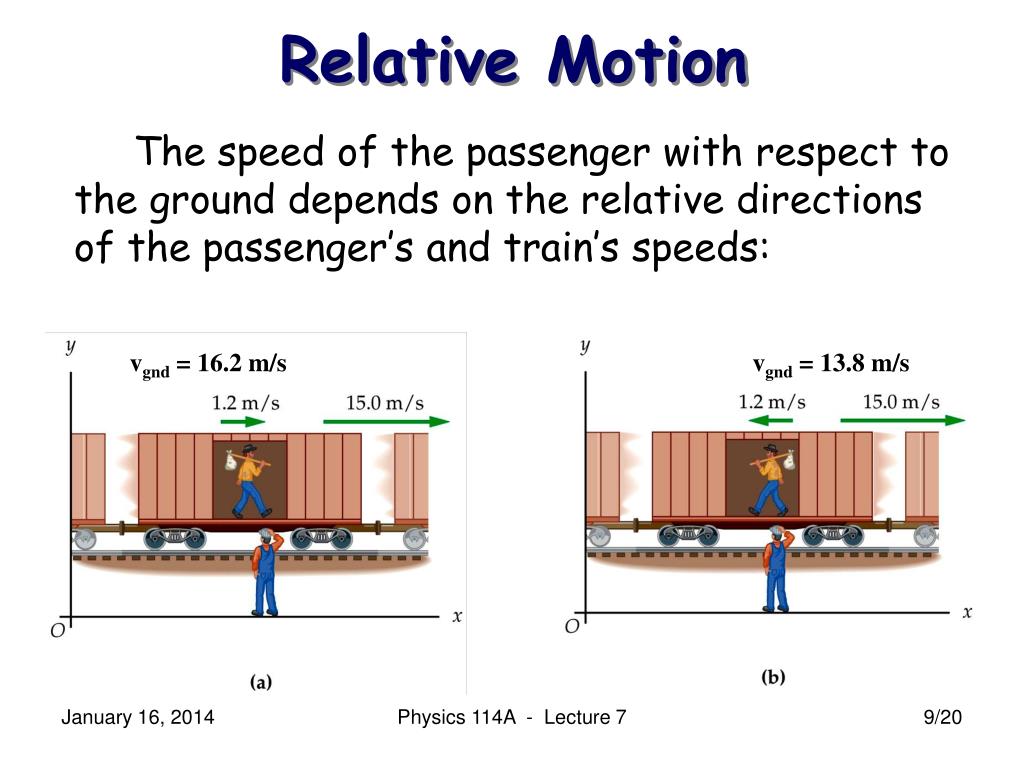

In the case of the airline passenger, everything around her is moving at the same speed. To a passenger in either car, it would appear that the other car is approaching at a speed of 35 m/s.We introduce relative motion in one dimension first, because the velocity vectors simplify to having only two possible directions. You may remember from physics class that all motion is relative. In mechanics: Relative motion A collision between two bodies can always be described in a frame of reference in which the total momentum is zero.

Two cars are travelling towards each other on a road. \(Relative~speed = speed~of~object~1 + speed~of~object~2\) Objects moving in opposite directions towards, or away from, each other To a passenger in the red car, the blue car appears to be travelling past at 5 m/s. The blue car is travelling at 25 m/s in front of the red car, which is travelling at 30 m/s. It is determined by assuming the second object is fixed, that is, that it has no. Take the example of the person sitting in a train moving east. What is Relative Motion Relative motion is defined as the motion of one object with respect to another object. Two cars are travelling in the same direction on a road. We introduce relative motion in one dimension first, because the velocity vectors simplify to having only two possible directions. \(Relative~speed = fastest~speed - slowest~speed\) The calculation for relative speed depends on whether the objects are moving in the same direction or the objects are moving in opposite directions towards, or away from, each other. This is because of their relative motion to each other. If you have travelled in a car on the motorway, you may have noticed that other cars passing by appear to move slowly past you, even though you know the actual speeds of the two cars are very high. In four minutes, you've travelled four hundred metres.Īll the way to ten minutes, you've travelled a thousand metres, the distance from home to school. This is because of their relative motion to each other. On this page I put together a collection of relative velocity problems to help you understand relative velocity better.

In three minutes, you've travelled three hundred metres. Relative motion If you have travelled in a car on the motorway, you may have noticed that other cars passing by appear to move slowly past you, even though you know the actual speeds of the two cars are very high. So in two minutes, you've travelled two hundred metres. Relative velocity in one and two dimensions using vector notation - position vectors and vector derivatives.Calculation of relative acceleration in two. It means literally that in one minute, you've travelled one hundred metres. Suggested activities: The importance of relative speed could be investigated with reference to collisions. What does it mean to travel at one hundred metres per minute? Relative motion (speed) is covered at KS3 but not explicitly at KS4. Now, that makes sense, if you think about it, this definition of speed. Your speed is the distance divided by the time, one thousand divided by ten equals one hundred metres per minute, which is quite a fast walk or even a bit of a jog. You have to travel one thousand metres in ten minutes. In this case, that means one thousand metres, distance from home to school, divided by ten minutes, the time you've allowed yourself. For example, consider a person, Alice, moving inside of a train headed for the French town of Nice. Sometimes, it can be more convenient to use an axis that is moving. What speed do you have to walk or run to get to school on time? In order to describe the motion of an object confined to a straight line, we introduced a an axis ( x) with a specified direction (in which x increases) and an origin (where x 0 ).

Let's say that you're going to go from home to school, and school is one kilometre away from your house, that's a thousand metres.Īnd you've left yourself ten minutes to make that journey. We introduce relative motion in one dimension first, because the velocity vectors simplify to having only two possible directions. Let's think now about the concept of motion and in particular, the idea of speed. Newtons laws of motion, combined with his law of gravity, allow the prediction of how planets, moons, and other objects orbit through the Solar System, and they are a vital part of planning space travel. The relative motion splint was initially developed to facilitate postoperative rehabilitation after repair of extensor tendon injuries at the dorsum of the hand and forearm.It has subsequently been used for rehabilitation of sagittal band injuries and after repair of closed attrition extensor tendon ruptures in rheumatoid arthritis.


 0 kommentar(er)
0 kommentar(er)
